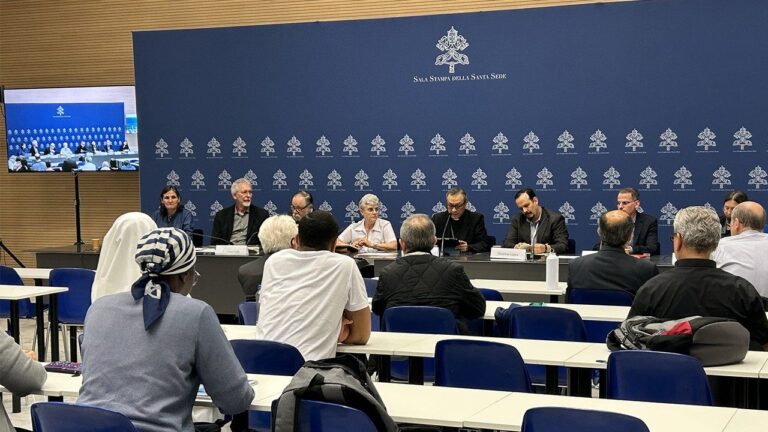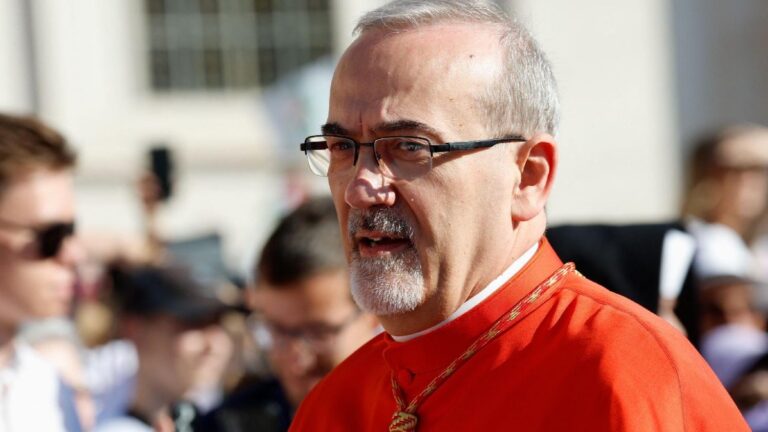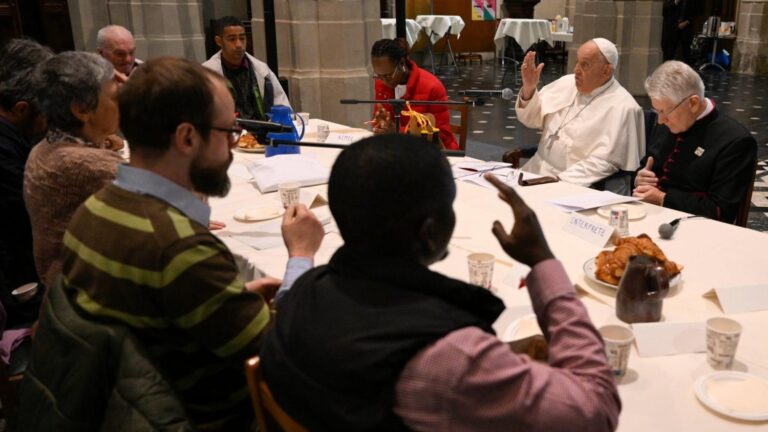The Baldacchino and the Altar of the Chair of St. Peter’s Basilica
During the closing mass of the XVI Ordinary General Assembly of the Synod of Bishops, the canopy above the tomb of Saint Peter will be inaugurated after nine months of restoration. From October 27 to December 8, the ancient pulpit of Saint Peter will be exposed at the foot of the high altar before being reinstalled on Bernini’s bronze throne.
By Johanna Bronkova
As you enter the main nave of St. Peter’s Basilica, you are struck by the immensity of the space. Suddenly, everything seems to shrink and we have a new perception of our environment, as if we were facing a majestic work of nature.
However, the architecture has its own order and the eye is immediately drawn to two focal points within the interior space: the papal altar with the canopy above the tomb of Saint Peter and the altar chair at the end of the basilica.
Both relate to the patronage of the basilica and offer a key to interpretation to the attentive observer. Not only are they the work of the same artist, Gian Lorenzo Bernini, but the artist himself connects them to each other. Upon entering the basilica, it is obvious that the monumental bronze canopy frames, in perspective, the altar of the chair of Saint Peter, located in the apse.
It is no coincidence: if the papal altar above the tomb of the Apostle – on which, like a rock, Christ promised to build his Church (Mt 16:18) – refers to the origins, to the primitive Church born from the testimony of martyrs (hence the name Altar of Confession), the Chair recalls the primary mission of Peter’s successors: to announce the Gospel and instruct the People of God.
THE Canopy
THE canopya former symbol of authority and prestige, was designed by Bernini in 1624 as his first architectural commission and was completed – apparently with the engineering expertise of his future rival, the brilliant architect Francesco Borromini – in 1633.
The challenge entrusted to him by Pope Urban VIII, whose heraldic figures – bees – are found in various forms throughout the world. canopyThe decoration of the church was aimed primarily at creating an architecture that would correspond to the monumental scale of the church.
To avoid making the structure appear too bulky, Bernini opted for twisted columns. In addition, their shape and decoration are linked to what is called the “Holy Column”, preserved today in the Treasury Museum of Saint-Pierre, a twisted column which for centuries would have been the witness to the preaching of Jesus in the temple of Jerusalem.
Along with similar columns, some of which are still visible in the Loggia of the Relics above the pillar balconies, they adorned the 4th century pergola above Peter’s tomb in the ancient basilica.
Bernini’s ingenious composition, however, combines the idea of a ciborium as a solid architectural structure with the original meaning of a canopy as decorative drapery over an important place or figure. It integrates bronze curtains directly into the columns and uses a lightweight construction of curved ribs complemented by the iconographic motif of palm branches, seemingly supported by dynamic angelic figures.
The undulating lines of Baroque architecture culminate in the cross atop the golden globe at canopyembodying the ancient saying: “Stat Crux dum volvitur orbis”: the cross stands firm as the world turns.
The Altar of the Chair
In a way, the Baroque era was a lot like ours. In modern terms, it could be called multimedia in its quest to use various artistic techniques to engage all the human senses, to involve the viewer to the point of breaking down the barriers between subjective and objective, making them participants in a new reality, a living reality. element of a “beautiful synthesis”, a vision of the universe animated by the Spirit of God.
An example – or almost a prototype – of this transformed reality, conscious of the divine presence, which bursts into our space uniting heaven and earth, is the apse of Saint Peter’s Basilica.
The entire back wall of St. Peter’s Basilica forms a veritable scene in which Bernini unfolds an astonishing vision before our eyes.
Even during work on the canopy above the tomb of the Apostle Peter, Bernini’s contemporaries called him the “Michelangelo of our century”, and now, at the request of Alexander VII, he proves that these words were not simple flattery .
If, in Michelangelo’s design of the apse of the new Vatican basilica, light played a crucial role as an equal counterpart to the shaped mass of the masonry, Bernini perfected this sculptural principle by composing a vision of the sky open.
From this opening emerges a dove symbolizing the Holy Spirit, bathed in light, surrounded by angels flying among the clouds. From this vision descends an enormous bronze throne, hiding beneath it a much smaller throne, on which, according to tradition, Saint Peter would have preached. The ancient seat, decorated with ivory plaques depicting the labors of Hercules, arrived in Rome in the 9th century as a gift from the Frankish king Charles II the Bald to Pope John VIII, although some elements such as the panels probably date from an earlier period.
Some might view Bernini’s composition as a sort of colossal reliquary, but perhaps that is not the point. Indeed, the monumental scene, created between 1657 and 1666, recalls the immutable mission of Peter’s successors: to announce Christ, interpret and teach the Word of God.
This is why, above Peter’s seat, hovers the symbol of the Holy Spirit, who leads us to all truth, the Comforter and Intercessor Spirit (Jn 14, 17, 14, 26, 16, 13) , but who also inspires us with the right words in times of crisis (cf. Lk 12:12).
On each side of the throne are four eminent theologians: Saint Ambrose and Saint Augustine, Fathers of the Western Church, and Saint Athanasius and Saint John Chrysostom, Fathers of the Eastern Church, who, with a gentle gesture , almost with their fingertips, they seem to lift the throne.
The bronze armchair is itself decorated with reliefs of three evangelical scenes illustrating the papal mission as representative of Christ on earth: “Feed my sheep” (Jn 21:17) – entrust the human flock to Peter; the washing of feet (Jn 13:14) – demonstrating the nature of his ministry; and finally the Handing over of the Keys of the Kingdom of Heaven (Mt 16:19).
The immense throne, too big for a human being, shows that it is not up to humanity to decide who will sit there.






